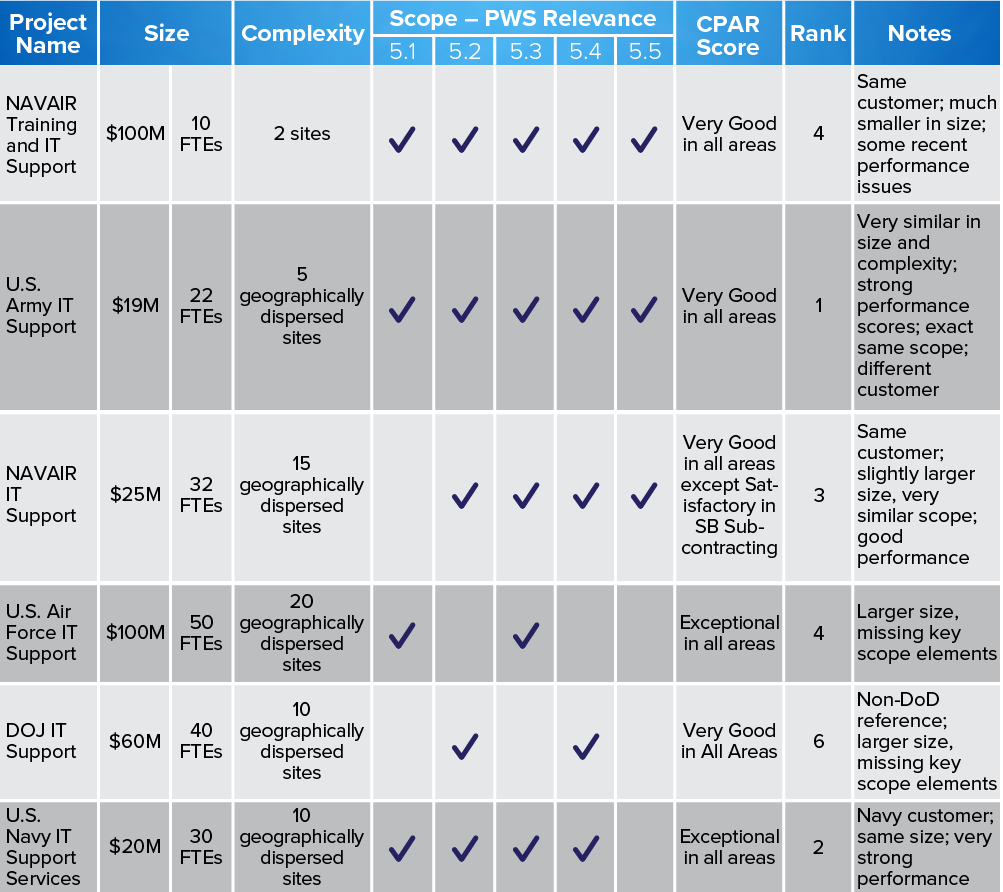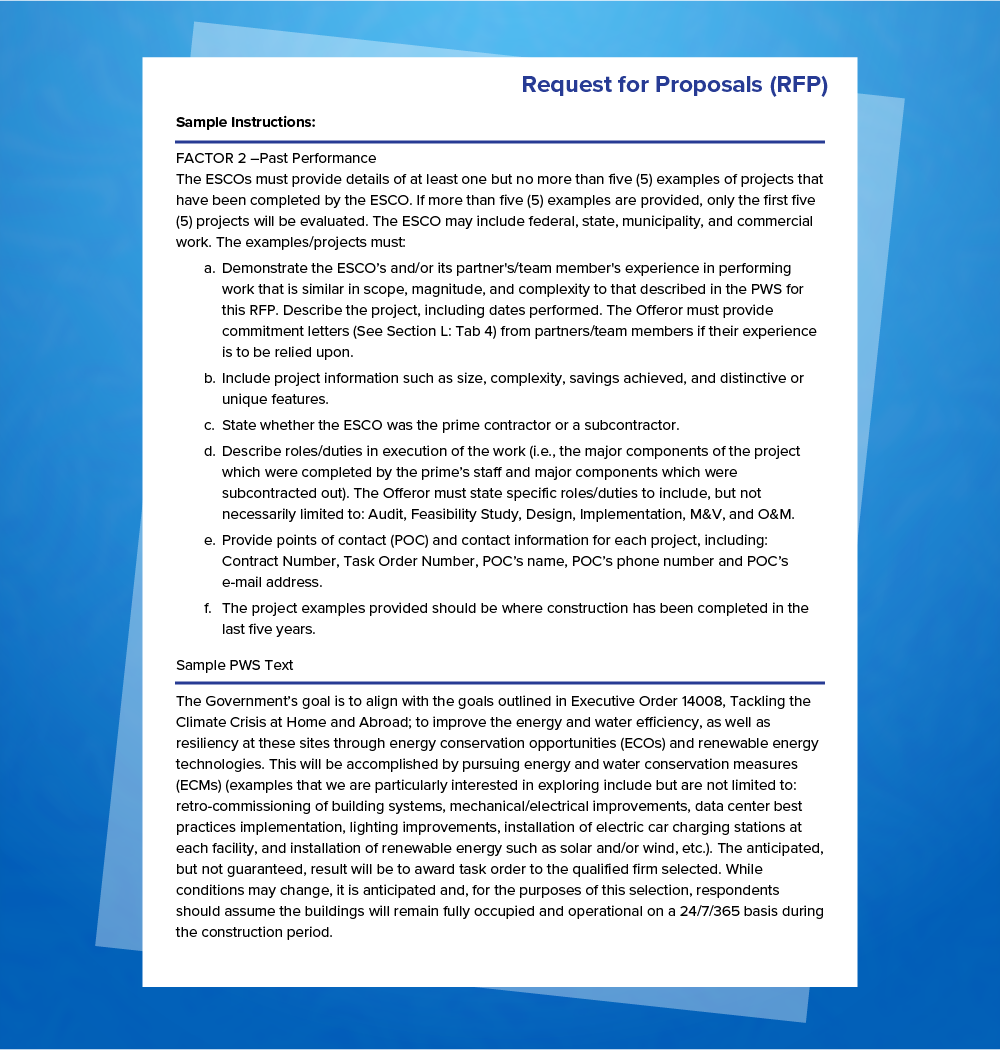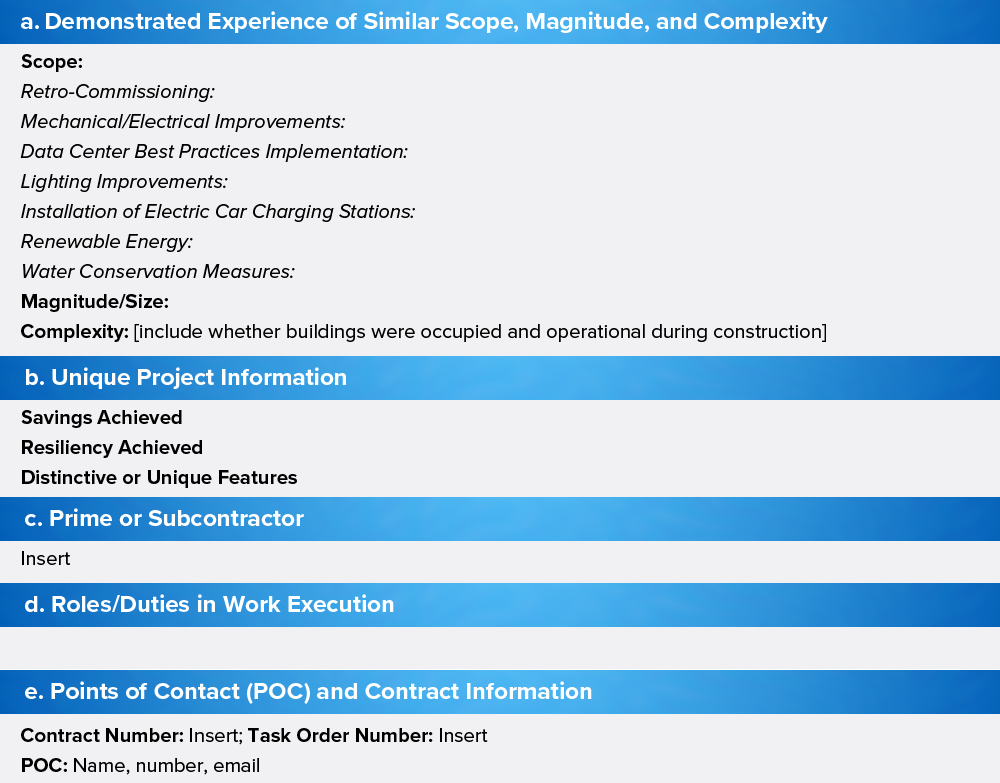
As part of the federal contracting process, procuring agencies are interested in an offeror’s quality of product/service, cost control, timeliness of performance, business relations, and customer satisfaction, as evidenced by its past performance.
Therefore, particularly when past performance is a high evaluation criterion, as stated in a Request for Proposal (RFP), successful proposal efforts require you to present a strong past performance portfolio. This is because Government agencies view contractors with positive past performances as likely to perform well again in the future. In this article, we’ll examine six ways you can maximize your score in this critical evaluation area:
- Select a Portfolio of Projects to Maximize Your Score
- Start with a Compliant Template
- Demonstrate Relevancy
- Tie the Past Performance Work to the Work You’re Bidding On
- Use Metrics and Proof Points
- Add a Meatball Chart to Your Introduction, if Allowable
1. Select a Portfolio of Projects to Maximize Your Score
In most Government solicitations, the contracting organization requires a minimum of three references for work performed within the past (typically within three to five years). The Government strictly evaluates an offeror’s compliance with the technical requirements and performance standards stipulated. Frequently, you’ll note language about the Government evaluating how similar the reference is in terms of size, scope, and complexity.
However, remember that in your past performance section, the Government is not only looking to see that your company has performed similar work, they are also looking to see that you have performed well. For this reason, it is also important to consider your current relationship with the customer, as well as how well you have scored on Contractor Performance Assessment Reports (CPARs) in the past. It’s also important to understand that although the Government relies heavily on the Past Performance Information Retrieval System (PPIRS), and/or Past Performance Questionnaires (PPQs) in evaluating past performance, the Government reserves the right to consult other sources, such as phone calls to personnel within agencies the contractor has previously worked for, even if they are not listed as references.
Despite all this, you still want to put forward the best portfolio of references possible. To understand how well each of your references might score in the eyes of evaluators, it can be helpful to set up a past performance scoring matrix similar to the one below. You should tailor your ranking matrix to align with the evaluation criteria and scope elements as outlined in the RFP and Statement of Work (SOW) or Performance Work Statement (PWS).

We recommend that you give your references notice that you will be listing them in the proposal. It’s even better if you are able to brief your references on the solicitation and provide them with key points to talk about. It is your responsibility to make this easy for your references as it is likely you’ll require their assistance again in the future. Important tips for selecting references include:
- Choose references that will speak highly of your work
- Double-check contact information
- Be aware of when the reference will be contacted and remember that references are human; try to ensure that any negatives associated with this contract or other contracts in the reference’s purview are ironed out before references are contacted
2. Start with a Compliant Template
After you’ve selected your past performance references, you’ll want to establish a compliant template. If the Government has provided a template in the RFP, you must use that template. However, if the Government has not provided a template, you will need to create one to include in your proposal.
The RFP will often provide the required format with a list of the required contract information (e.g., contract number, contract type, dollar value, period of performance, customer, Contracting Officer, Contracting Officer’s Technical Representative, and brief description). Carefully follow the instructions provided in the RFP and present contractual data in the order requested in the RFP. Remember to abide by any font restrictions and page limitations relevant to the past performance.

3. Demonstrate Relevancy
When developing your past performance narratives, you’ll want to indicate the project’s relevancy in terms of size, scope, and complexity:
- Size: This can include things like dollar value, FTEs, building sizes, number of end users, etc.
- Scope: Include bold or italicized headings for each SOW or PWS area and a brief narrative demonstrating the relevance
- Complexity: This can include things like multiple geographically dispersed sites, multiple customers, challenging locations or weather conditions, security requirements, 24/7 requirements, vendor/contractor coordination requirements, etc.
By tying in the relevance for the evaluator, you will help to make their jobs easier. Consider using wording such as the following:
- This $XM project is the same size as the XYZ contract, with X FTEs supporting X users
- This $XM project is larger in size as the XYZ contract, with X FTEs supporting X users
- This project is the exact same scope as the XYZ contract, covering 100% of scope elements, including A, B, C, D, and E
- This project is very similar to the scope of the XYZ contract, covering 80% of the scope elements, including A, C, D, and E
- Like the XYZ contract, this project is highly complex, requiring OCONUS support at sites with unreliable coastal conditions. Additionally, work is performed in highly secure areas, as well as in buildings that are occupied 24/7, requiring close schedule coordination with the customer
4. Tie the Work to the Work You’re Bidding On
It’s also important to tie the project’s work to the work you’re bidding on. Go beyond general size, scope, and complexity by using statements that indicate how exactly the work is relevant. For example, you might include phrases such as the following:
- We will apply this same software development model on the XYZ contract to deliver similar schedule efficiencies
- Similar to the XYZ contract, this work entailed extensive 508 compliance requirements.
- This project included very similar security requirements, where we provided TS/SCI-cleared electricians to perform the electrical buildout in the SCIF areas
- Similar to the XYZ contract, this project required achieving Authority to Operate under DOD Risk Management Framework (RMF). We will leverage best practices and our documented methodology from this project to successfully achieve ATO for customer X
5. Use Metrics and Proof Points
To further substantiate the similarity of the work in terms of size, scope, and complexity, use metrics where possible. Metrics provide teeth to your claims and serve to help the evaluator draw more concrete conclusions on how similar the work actually is. For example, instead of stating, “We performed lighting replacements, creating significant energy savings,” you might write: “We replaced XX lights with LED, resulting in energy savings of X MbTU annually.”
Below are some examples of safety-related proof points containing metrics.

Remember that past performance must not only demonstrate how similar the work is, but also how well you performed. Throughout your narrative, weave in statements and proof points that demonstrate efficiencies, innovations, etc. You’ll also want to address your performance in terms of cost, schedule, quality, and any other areas called out in the solicitation (e.g., Management, Small Business Participation, Regulatory Compliance, etc.).
If space allows, you’ll want to include this information in your write-ups to back-up the information that the Government may also gather from CPARs and/or Past Performance Questionnaires.
6. Add a Meatball Chart to the Introduction, If Allowable
If allowable by the RFP restrictions, KSI recommends including an introduction to the Past Performance section to precede the project profiles, which summarizes the work. To facilitate at-a-glance evaluation, consider using a meatball chart similar to the one shown below. The meatball chart:
- Serves as an at-a-glance summary of relevance in terms of size, scope, and complexity
- Can help evaluators do a quick check to see if all SOW/PWS areas are covered
- Should be backed up by the narratives we discussed earlier in this article

Final Thoughts
Particularly when past performance is a high evaluation criterion as stated in an RFP, successful proposal efforts require you to present a strong portfolio of past performance. This is because Government agencies view contractors with positive past performances as likely to perform well again in the future. When writing your past performance sections, you’ll want to:
- Select the right portfolio of projects
- Develop and complete a compliant past performance template
- Demonstrate the relevancy of your projects
- Tie the work of those project to the work you’re bidding on
- Make sure you’re using metrics and proof points
- Add a meatball chart to your introduction, if allowable
Following these steps and guidelines will help ensure you’re maximizing your scoring potential for past performance and will get you one step closer to that winning proposal.









